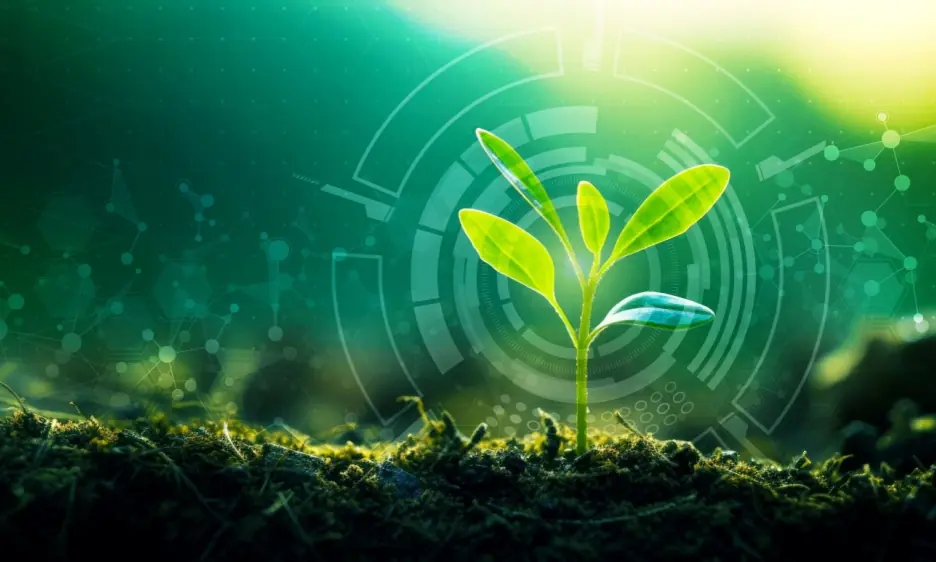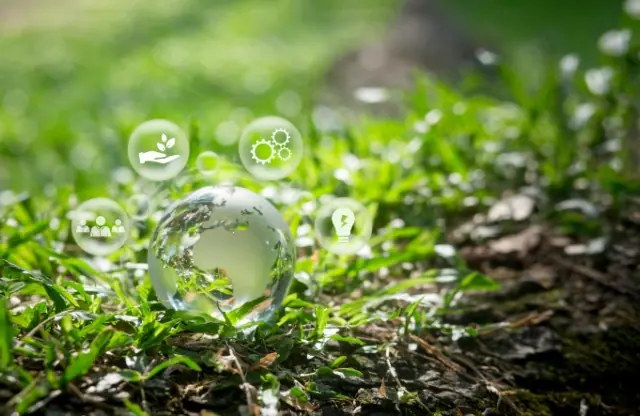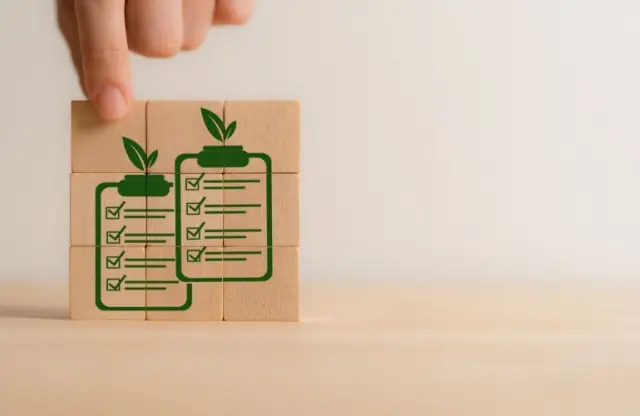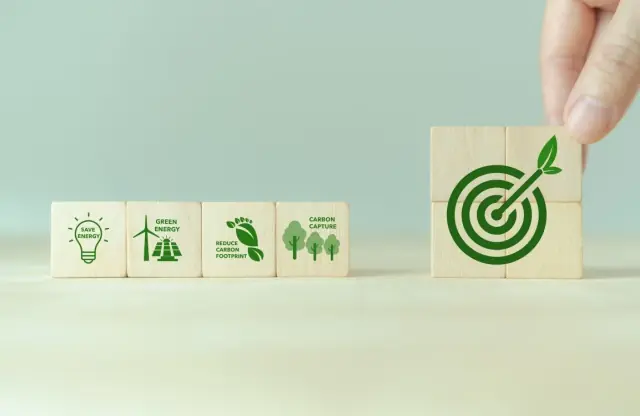An Informative Guide to Cradle-to-Cradle Design
 Share
Share
 Copy Url
Copy Url

Cradle-to-cradle design is changing how we think about product lifecycles. Unlike the traditional cradle-to-the-grave approach, where products become waste, cradle-to-cradle design ensures materials are reused or safely returned to the environment. But what is cradle-to-cradle design? It’s more than just recycling; it’s about creating fully sustainable products, from beginning to end. As businesses face more pressure to meet sustainability reporting standards and create thorough sustainability reports, cradle-to-cradle design is becoming even more important. We'll explore how this concept compares to Life Cycle Assessment (LCA) and why it’s a game-changer for sustainable product design.
Cradle-to-cradle design is a smart and innovative way to think about products from start to finish. This article will explain what cradle-to-cradle design is, the main ideas behind it, and how it’s different from the cradle-to-the-grave mindset. We’ll also discuss how it’s used in product design, like reusing parts and recycling materials. Plus, we’ll look at the environmental, economic, and social benefits that make this approach so appealing. Finally, we'll talk about how cradle-to-cradle design supports sustainability. Whether you’re new to this idea or want to learn more, this guide has you covered.

What is Cradle-to-Cradle Design?
Cradle-to-cradle design, also known as C2C design, is a new approach to creating products. It aims to eliminate waste and promote sustainability. Unlike the cradle-to-the-grave model, where products become waste at the end of their life, cradle-to-cradle design ensures that materials are reused, recycled, or biodegraded. This approach mimics nature’s process, where waste from one organism becomes useful for another, creating a continuous and regenerative cycle. By adopting C2C design, businesses can align their practices with the circular economy. This alignment helps reduce environmental impact and conserves resources.
An important aspect of this design is creating products that can be disassembled at the end of their life. These products, known as cradle-to-cradle products, are designed with both biological and technical cycles in mind. In a closed-loop system, materials are either safely returned to the environment as nutrients or reused to make new items. This approach reduces waste and minimizes the use of new resources. Additionally, it supports the use of renewable energy. As a result, it not only benefits the environment but also saves money by reducing waste disposal costs.

Criteria of Cradle-to-Cradle Design
Cradle-to-cradle design, also called C2C design, is a way of making products that fit into a circular economy. This approach focuses on using materials that can be reused, recycled, or safely biodegraded. It aims to support sustainable development by reducing environmental impact throughout the product's life.
Material Health: The materials in products must be safe for people and the environment. This means using non-toxic substances that don't cause harm at any point in the product's lifecycle. Products should be free from harmful chemicals, ensuring they are good for the environment.
Material Reutilization: Products should be made in a way that allows their materials to be easily recovered and recycled. After the product's useful life, its materials can be reclaimed and reused in new products. This supports the closed-loop system important to the circular economy.
Renewable Energy Use: At least 50% of the energy used in making these products should come from renewable sources. This helps reduce reliance on fossil fuels and supports a business model that cuts carbon emissions.
Water Stewardship: Water used in production should come from sustainable sources and be managed responsibly. This means reducing water usage, treating it safely before it’s released, and ensuring it doesn’t harm the environment.
Social Fairness: Companies should act with social responsibility, promoting fair labor practices and diversity. They should also positively impact their communities and ensure their business practices respect human rights.
These criteria help make sure that cradle-to-cradle products reduce waste and environmental harm. They also support broader goals of sustainability and ethical business practices. By following these guidelines, businesses can align with sustainability reporting frameworks and create products that help make the planet healthier.

Cradle-to-Cradle Design Principles
Cradle-to-cradle design is a sustainable way of making products that are good for the environment throughout their entire life. It is based on three main principles that help reduce the ecological footprint and support sustainable development. Here are the key principles:
1. Waste Equals Food
This idea comes from nature, where waste from one thing becomes food for another. In cradle-to-cradle design, products are made so that when they reach the end of their life, their materials can either break down safely or be used again to make new products. This reduces waste and the negative effects on the environment.
2. Use Current Solar Income
This principle focuses on using renewable energy, like solar and wind power. By using clean, abundant energy, cradle-to-cradle design reduces the need for non-renewable resources, lowering the ecological footprint of production. This also helps in achieving sustainable development goals.
3. Celebrate Diversity
This principle values diversity in materials, processes, and cultures. Products are designed to fit different environments and needs, making sure they work well and last long. This helps support the lifecycle of a product by matching it to the unique features of each place.
These principles are the foundation of cradle-to-cradle design. They not only reduce waste but also make products and systems more sustainable. By following these ideas, businesses can meet sustainability reporting frameworks and create products that are good for the environment.

Benefits of Cradle-to-Cradle Design
Cradle-to-cradle design is a powerful approach that brings big benefits in environmental, economic, and social areas. It focuses on regenerative design, which means creating products in a way that lowers their environmental footprint and supports the circular economy. Here are the main benefits:
Environmental Benefits
Cradle-to-cradle design helps reduce the environmental footprint by making sure products are made from materials that can be reused, recycled, or safely biodegraded. By using the C2C model, it minimizes waste and decreases the need for raw materials. This approach also supports upcycling, where materials keep or even improve their quality when reused, contributing further to environmental sustainability.
Economic Benefits
Using cradle-to-cradle design principles can bring major economic benefits. Businesses can save money by reusing materials and cutting down on waste disposal costs. The C2C model also creates new business opportunities by encouraging the development of innovative products designed with circularity in mind. These products often lead to cost savings and can make a company more competitive in the market.
Social Benefits
Cradle-to-cradle design also offers social benefits, such as better public health and well-being. By using non-toxic materials and reducing pollution, the C2C model helps create healthier living environments. It also supports job creation in industries focused on recycling, remanufacturing, and maintenance, which helps build stronger communities and encourages social innovation.
These benefits show how cradle-to-cradle design is a well-rounded approach that not only helps the environment but also boosts economic growth and improves social well-being. By adopting this model, businesses can work towards a more sustainable and fair future.

Cradle-to-Cradle vs. Cradle-to-Grave
Cradle-to-Cradle (C2C) and Cradle-to-Grave (C2G) are two approaches to the lifecycle of a product. Both consider the environmental impact of a product from its creation to the end, but they differ significantly in what happens at the end of the product's life. Below is a comparison of the two concepts:
Cradle-to-Grave
1. Linear Lifecycle
Cradle-to-grave follows a linear path where products are made, used, and eventually discarded as waste. The product lifecycle begins at raw material extraction (birth) and ends with disposal (death), hence "birth to death." This leads to significant waste and environmental harm.
2. Environmental Impact
The environmental impact of a product in this model is high, as materials are often not reused or recycled. This method relies on continuous raw material extraction and waste generation, increasing greenhouse gas emissions and the overall environmental footprint.
3. No Reuse
Products in a cradle-to-grave model are typically not designed for reuse or upcycling. Once they are discarded, their materials are rarely recovered, leading to a one-way flow of resources that does not promote sustainability.
Cradle-to-Cradle
1. Circular Lifecycle
Cradle-to-cradle focuses on creating products that you can recycle or upcycle at the end of their lifecycle. Designers create products that can be disassembled into reusable raw materials. This supports a regenerative design that imitates nature’s endless cycles.
2. Reduced Environmental Impact
By closing the loop in the product lifecycle, cradle-to-cradle reduces the environmental impact of a product. Products designed this way lower the need for new raw material extraction and reduce waste. In turn, this reduces greenhouse gas emissions and promotes a sustainable lifecycle.
3. Upcycling and Reuse
In the cradle-to-cradle model, waste becomes a resource. Materials are upcycled, meaning they are repurposed into higher-quality products. This circularity ensures that materials are kept in use for as long as possible, reducing waste and the environmental footprint
In summary, while cradle-to-grave leads to waste and environmental damage, cradle-to-cradle encourages recycling and upcycling, reducing the environmental impact of products and supporting sustainability.

Role of Cradle-to-Cradle Design in Sustainability
Cradle-to-cradle design plays a crucial role in sustainability by addressing environmental concerns and promoting a circular economy. This approach ensures that products are created to be reused or recycled indefinitely, rather than ending up as waste. It helps reduce the environmental impact of a product by keeping materials in a continuous cycle of use, thus minimizing the need for raw material extraction.
In C2C design, products are seen as either biological or technical nutrients. Biological materials are biodegradable and can return to nature without harm, while technical materials can be disassembled and upcycled into new products, enhancing resource efficiency. This process supports both eco-effectiveness and sustainability by reducing waste and pollution.
C2C design encourages a shift from efficiency to effectiveness. Rather than simply reducing harm (as in traditional sustainability efforts), C2C aims to create products with a positive environmental footprint. This regenerative design approach ensures that materials are used to benefit both people and the planet.

Cradle-to-Cradle Design and Sustainability Reporting: A Perfect Match
Cradle-to-cradle design goes beyond just reducing waste. It’s a complete approach to making products that support environmental, social, and economic sustainability. By reusing, recycling, and upcycling materials, cradle-to-cradle design helps lower the environmental footprint and promotes the circular economy. This approach fits well with sustainability reporting, as it encourages companies to track their efforts in reducing waste, cutting greenhouse gas emissions, and ensuring efficient use of resources over time.
For expert help with sustainability reporting, turn to Report Yak, one of India’s top report design agencies. We specialize in creating impactful annual reports, ESG reports, and sustainability reports for multinational organizations. Visit our Showcase page for samples or browse our website for a full list of services. For inquiries, contact us via WhatsApp, call 1800 121 5955 (India), or email us at contact@reportyak.com. Alternatively, fill out our Contact Form on the website, and we’ll respond promptly.
Related Posts
-
How To Adopt BRSR Guidelines For Success
Oct 15, 2025Share
Copy Url
Simplifying ESG Disclosure for Better Impact
corporate reportingenvironmental and social initiatives
+6
Aug 28, 2025Share
Copy Url
GRI Sustainability Taxonomy: Learn How to Turn Data Into Advantage
corporate governancecorporate reporting
+11
Jul 1, 2025Share
Copy Url


